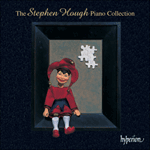
Welcome to Hyperion Records, a British classical label devoted to presenting high-quality recordings of music of all styles and from all periods from the twelfth century to the twenty-first.
Hyperion offers both CDs, and downloads in a number of formats. The site is also available in several languages.
Please use the dropdown buttons to set your preferred options, or use the checkbox to accept the defaults.

Franck’s original registration is quite specific in colour, particularly his love of reeds with their piercing timbre. It is interesting that at the moments of greatest melodic and harmonic sweetness in all three Chorales Franck asks for the most sour stops to be drawn. In the third Chorale, in the glorious central section, the left hand and pedals are gently painting a wash of harmonic colour with flutes and bourdon, whilst the ‘endless melody’ on the Swell manual has to be etched with the acid of the combined oboe and trumpet stops. However, this is one of the peculiarities of Franck’s style—the non troppo dolce that appears quite often in the piano works—with its poignant, emotional tug between the austere and the sentimental: the ice-cold marble altar, but the burning candles and the sweet incense.
from notes by Stephen Hough © 1997
La registration originelle de Franck est d’une couleur à part, où transparaît surtout l’amour du compositeur pour les anches et leur timbre perçant. Il est intéressant de noter qu’aux moments de plus grande douceur mélodique et harmonique, Franck demande, dans les trois chorals, que les registres les plus aigres soient tirés. Dans la glorieuse section centrale du troisième choral, la main gauche et les pédales peignent un discret lavis de couleur harmonique avec les flûtes et le bourdon, tandis que la «mélodie perpétuelle», sur le manuel de récit, doit être gravée à l’eau-forte, avec l’acide des registres de hautbois et de trompette combinés. Voilà cependant une des particularités stylistiques de Franck—le non troppo dolce, très fréquent dans les œuvres pour piano—, qui voit son combat intérieur, poignant et émotionnel, osciller entre austérité et sentimentalisme: l’autel de marbre glacial, mais les cierges ardents et l’encens suave.
extrait des notes rédigées par Stephen Hough © 1997
Français: Hypérion
Francks eigene Registrierung hat eine ganz spezifische Färbung, vor allem im klangschallende Timbre der Rohrblattinstrumente, für die er eine Vorliebe hatte. Interessant ist auch, daß er in allen drei Chorälen gerade an den Stellen, wo die höchste melodische und harmonische Süße ausgedrückt wird, die sauersten Register ziehen läßt. Im herrlichen mittleren Satze des dritten Chorals schaffen linke Hand und Pedale eine sanfte harmonische Tönung mit Flöten und Bourdon, während die „nicht enden wollende Melodie“ auf dem Schwellmanual mit der Säure der Oboen-und- trompetenregistern geätzt werden muß (in diesem Zusammenhang siehe den häufigen Gebrauch des non troppo dolce in seinen Klavierwerken). Dieser Zwiespalt ist charakteristisch für Francks Ausdrucksstil, die Darstellung einer seelischen Zerrissenheit zwischen dem Strengen und dem Sentimentalen, zwischen eiskaltem Marmoraltar einerseits und brennenden Kerzen mit süßlichem Weihrauch andererseits.
aus dem Begleittext von Stephen Hough © 1997
Deutsch: Margaret Morey
 The Stephen Hough Piano Collection The Stephen Hough Piano Collection'This is a fine introduction to the piano playing of one of the great talents of the present age' (MusicWeb International)» More |

